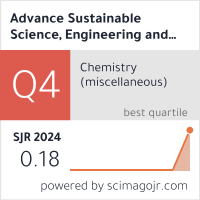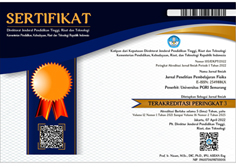Urban Expansion, Climate Vulnerability, and Transportation Resilience: Insights for Sustainable Development
DOI:
https://doi.org/10.26877/asset.v7i3.1495Keywords:
sustainable transport, climate resilience, urban climate adaptation, impervious surface modelling, spatial analysisAbstract
Climate change poses a significant threat to transportation infrastructure, particularly in rapidly urbanizing regions like Bumi Serpong Damai (BSD) City, Indonesia, which faces increased risks of flooding and the urban heat island (UHI) phenomenon. However, limited research has assessed the combined impacts of climate and land use changes on infrastructure resilience. This study addresses this gap by integrating remote sensing analysis, climatological data, field observations, and stakeholder interviews to identify key vulnerabilities. The results highlight that low-lying and high-impermeability areas, such as the BSD highway and Central Business District (CBD), are highly susceptible to flooding and UHI effects. To enhance resilience, the study proposes structural, nature-based, and technology-driven adaptation strategies, including improved drainage, sponge city concepts, and IoT-based climate monitoring. These findings provide essential insights for urban planners and policymakers, emphasizing the need for climate-adaptive infrastructure planning and sustainable urban development policies.
References
[1] J. B. Leicht and M. Leicht, “Climate change and transportation companies: A bibliometric and systematic literature review,” Transp. Res. Part F Traffic Psychol. Behav., vol. 101, no. December 2023, pp. 160–185, 2024, doi: 10.1016/j.trf.2024.01.001.
[2] H. Vajjarapu, A. Verma, and H. Allirani, “Evaluating climate change adaptation policies for urban transportation in India,” Int. J. Disaster Risk Reduct., vol. 47, no. October 2019, p. 101528, 2020, doi: 10.1016/j.ijdrr.2020.101528.
[3] T. Esch et al., “Breaking new ground in mapping human settlements from space – The Global Urban Footprint,” ISPRS J. Photogramm. Remote Sens., vol. 134, pp. 30–42, Dec. 2017, doi: 10.1016/j.isprsjprs.2017.10.012.
[4] F. Ferrario, J. M. Mourato, M. S. Rodrigues, and L. F. Dias, “Evaluating Nature-based Solutions as urban resilience and climate adaptation tools: A meta-analysis of their benefits on heatwaves and floods,” Sci. Total Environ., vol. 950, p. 175179, Nov. 2024, doi: 10.1016/j.scitotenv.2024.175179.
[5] B. D. Leibowicz, “Urban land use and transportation planning for climate change mitigation: A theoretical framework,” Eur. J. Oper. Res., vol. 284, no. 2, pp. 604–616, 2020, doi: 10.1016/j.ejor.2019.12.034.
[6] D. Huber, T. Viere, E. Horschutz Nemoto, I. Jaroudi, D. Korbee, and G. Fournier, “Climate and environmental impacts of automated minibuses in future public transportation,” Transp. Res. Part Transp. Environ., vol. 102, no. December 2021, p. 103160, 2022, doi: 10.1016/j.trd.2021.103160.
[7] S. J. Ghoushchi et al., “Assessing Sustainable Passenger Transportation Systems to Address Climate Change Based on MCDM Methods in an Uncertain Environment,” Sustain. Switz., vol. 15, no. 4, 2023, doi: 10.3390/su15043558.
[8] C. J. Leon, Y. E. Lam González, G. Ruggieri, and P. Calò, “Assessing Climate Change Adaptation and Risk Management Programmes: Stakeholder Participation Process and Policy Implications for Transport, Energy and Tourism Sectors on the Island of Sicily,” Land, vol. 11, no. 8, 2022, doi: 10.3390/land11081206.
[9] S. Hänsel et al., “Climate services in support of climate change impact analyses for the German inland transportation system,” Meteorol. Z., vol. 31, no. 3, pp. 203–226, 2022, doi: 10.1127/metz/2022/1117.
[10] W. H. Beitelmal, S. C. Nwokolo, E. L. Meyer, and C. C. Ahia, “Exploring Adaptation Strategies to Mitigate Climate Threats to Transportation Infrastructure in Nigeria: Lagos City, as a Case Study,” Climate, vol. 12, no. 8, 2024, doi: 10.3390/cli12080117.
[11] B. Rathnayaka et al., “Identifying and prioritizing climate change adaptation measures in the context of electricity, transportation and water infrastructure: A case study,” Int. J. Disaster Risk Reduct., vol. 99, no. June, p. 104093, 2023, doi: 10.1016/j.ijdrr.2023.104093.
[12] “Dodman: Cities, settlements and key infrastructure - Google Scholar.” Accessed: Mar. 13, 2025. [Online]. Available: https://scholar.google.com/scholar_lookup?title=Cities%2C%20settlements%20and%20key%20infrastructure&publication_year=2023&author=Intergovernmental%20Panel%20on%20Climate%20Change%20(IPCC)
[13] V. Putri, I. Patriani, and F. Juliansyah, “Peran forum United Nstions Framework Convention on Climate (UNFCCC) Dalam mewujudkan Suistanable Fashion,” J. S1 Hub. Int., vol. 4, pp. 1–3, 2022.
[14] H. Iseki, “Challenges in implementing climate change policy within local climate action, transportation and land use planning in Japan,” Town Plan. Rev., vol. 95, no. 3, pp. 259–281, 2024, doi: 10.3828/tpr.2023.35.
[15] M. Islam and G. Kabir, “Navigating Climate Variability for the Pursuit of Transportation Infrastructure Sustainability: A Systematic Review,” Infrastructures, vol. 9, no. 10, 2024, doi: 10.3390/infrastructures9100182.
[16] Y. Shen, N. Tahvildari, M. M. Morsy, C. Huxley, T. D. Chen, and J. L. Goodall, “Dynamic Modeling of Inland Flooding and Storm Surge on Coastal Cities under Climate Change Scenarios: Transportation Infrastructure Impacts in Norfolk, Virginia USA as a Case Study,” Geosci. Switz., vol. 12, no. 6, pp. 1–24, 2022, doi: 10.3390/geosciences12060224.
[17] N. V. Peters and L. A. Reisch, “Drivers of and barriers to sustainable urban mobility plan implementation: Lessons from Copenhagen,” Case Stud. Transp. Policy, p. 101417, Mar. 2025, doi: 10.1016/j.cstp.2025.101417.
[18] M. Deveci, I. Gokasar, A. R. Mishra, P. Rani, and Z. Ye, “Evaluation of climate change-resilient transportation alternatives using fuzzy Hamacher aggregation operators based group decision-making model,” Eng. Appl. Artif. Intell., vol. 119, no. March 2022, p. 105824, 2023, doi: 10.1016/j.engappai.2023.105824.
[19] T. Wang, Z. Qu, Z. Yang, T. Nichol, G. Clarke, and Y. E. Ge, “Climate change research on transportation systems: Climate risks, adaptation and planning,” Transp. Res. Part Transp. Environ., vol. 88, no. October, p. 102553, 2020, doi: 10.1016/j.trd.2020.102553.
[20] T. B. da Silva, P. Baptista, C. A. Santos Silva, and L. Santos, “Climate change mitigation policies in the transportation sector in Rio de Janeiro, Brazil,” Environ. - MDPI, vol. 7, no. 11, pp. 1–22, 2020, doi: 10.3390/environments7110099.
[21] N. Setyaningrum, A. Darmawan, D. Fernando, I. F. Cahyaningtyas, and A. P. Perdana, “Land-use change and urban heat island phenomenon in Tangerang City,” 2021 IEEE Asia-Pac. Conf. Geosci. Electron. Remote Sens. Technol. AGERS 2021 - Proceeding, no. September, pp. 46–51, 2021, doi: 10.1109/AGERS53903.2021.9617392.
[22] A. Wibowo and A. Rustanto, “Spatial - Temporal Analysis of Urban Heat Island in Tangerang City,” Indones. J. Geogr., vol. 45, no. 2, pp. 101–115, 2013.
[23] E. Douglas et al., “Progress and Challenges in Incorporating Climate Change Information into Transportation Research and Design,” J. Infrastruct. Syst., vol. 23, no. 4, pp. 1–9, 2017, doi: 10.1061/(asce)is.1943-555x.0000377.
[24] L. A. Dundon, K. S. Nelson, J. Camp, M. Abkowitz, and A. Jones, “Using climate and weather data to support regional vulnerability screening assessments of transportation infrastructure,” Risks, vol. 4, no. 3, 2016, doi: 10.3390/risks4030028.
[25] H. Li, A. M. Kim, and J. Jin, “Transportation Infrastructure Decision Flexibility in Response to Climate Change and Demand Uncertainties: The Mackenzie Valley Highway in Canada’s Northwest Territories,” J. Infrastruct. Syst., vol. 28, no. 1, 2022, doi: 10.1061/(asce)is.1943-555x.0000655.
[26] A. Asadabadi and E. Miller-Hooks, “Assessing strategies for protecting transportation infrastructure from an uncertain climate future,” Transp. Res. Part Policy Pract., vol. 105, no. August, pp. 27–41, 2017, doi: 10.1016/j.tra.2017.08.010.
[27] A. M. Kim and H. Li, “Incorporating the impacts of climate change in transportation infrastructure decision models,” Transp. Res. Part Policy Pract., vol. 134, no. February 2019, pp. 271–287, 2020, doi: 10.1016/j.tra.2020.02.013.
[28] A. E. Hulu et al., “Spatial Analysis of Water Infiltration Potential in the Miu Watershed of Sigi Regency,” Adv. Sustain. Sci. Eng. Technol., vol. 5, no. 2, p. 0230208, Jul. 2023, doi: 10.26877/asset.v5i2.16626.
[29] C. M. Chang, O. Ortega, and J. Weidner, “Integrating the Risk of Climate Change into Transportation Asset Management to Support Bridge Network-Level Decision-Making,” J. Infrastruct. Syst., vol. 27, no. 1, pp. 1–10, 2021, doi: 10.1061/(asce)is.1943-555x.0000590.











